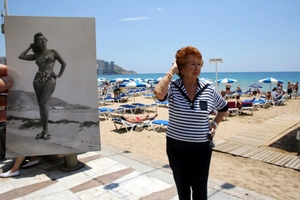Stuart:
Bikini Revolution is an incredibly thorough documentary about the history of those tiny bits of material that have been synonymous with beaches since the mid-40s.
The roster of talking heads here is incredible. You have the likes of Paul Vance, (writer of the hit “Itsy Bitsy Teenie Weenie Yellow Polka Dot Bikini”), famous photographer Bunny Yeager, self-proclaimed ‘bikini scientist’ Judson Rosebush as well as several former models who were amongst the first to wear the infamous outfit. It’s a wonderful collection of experts, historians and enthusiasts, and I suppose that the timing of the documentary was perfect, since many of them won’t be with us much longer.
You have the likes of Paul Vance, (writer of the hit “Itsy Bitsy Teenie Weenie Yellow Polka Dot Bikini”), famous photographer Bunny Yeager, self-proclaimed ‘bikini scientist’ Judson Rosebush as well as several former models who were amongst the first to wear the infamous outfit. It’s a wonderful collection of experts, historians and enthusiasts, and I suppose that the timing of the documentary was perfect, since many of them won’t be with us much longer.
The film also deals with the surprising/horrifying history of the term ‘bikini’ itself. When the swimsuit was introduced to the unsuspecting public in 1946, it happened to coincide with a series of nuclear tests conducted by the US in the Bikini Atoll, which is part of the Marshall Islands in the Pacific. The US, in a triumphant show of force, conducted a score of tests within the atoll’s lagoon, but not after forcing the Bikinians to move from their home, claiming that this was for the greater good of humanity (a weapon to end all wars, you see.) French engineer and inventor of the bikini, Louis Réard, called his creation the bikini simply because the atomic tests were all over the news of the day. The lazy yet brilliant connection between sexy women (bombshells) and atomic weapons on the beach was enough to make the name stick.
Directors Albert Knechtel and Kiko Ribeiro cut back and forth from studying the history of the bikini through the years to the current home of the former inhabitants of Bikini Island. Unsurprisingly, the bikini means nothing to them, and as a study of ‘forgotten’ people, this makes for rather sombre viewing. It is, of course, a generally light-hearted study of the bikini phenomenon – examining the differences between the European, North American and Brazilian approaches to skimpy swimwear, though it never delves very far into a feminist sociological approach to the subject matter. Indeed, the film only touches on feminism briefly. This is a pity because it’s easy to see that the bikini is regularly seen as being both freeing and a burden – women were free to express their sexuality in a way never before, but this only unleashed a culture of body sculpting (for lack of a better term) and impossibly high standards.
As a documentary, the film never gets sluggish. This is good, apart from the fact that it goes too far in the other direction – its kinetic, scattergun approach can be a little disorienting to the viewer, as they jump from topic to topic. This is a German production, though many of the interviewees are speaking in English. Unfortunately, the onscreen text that accompanies each person’s name wasn’t translated in the version I watched, which meant I often had to make an approximation as to their profession (my high school German being more than a little rusty.)
Exceptionally informative, Bikini Revolution is a great study of a sociological phenomenon that may at first seem insignificant but has had far-reaching consequences over the years.
Rating: